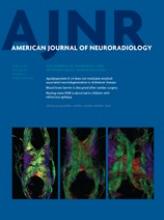Abstract
BACKGROUND AND PURPOSE: Flat panel detector–based CBCT can provide CT-like images of the brain without transferring patients from the angiography suite to a conventional CT facility. Conventional brain CT after uneventful endovascular treatment sometimes shows focal subarachnoid hyperattenuation with contrast leakage, mimicking SAH. Differentiating this finding from SAH is important for immediate postprocedural medical management. We investigated CBCT for detecting subarachnoid hyperattenuation immediately after coil embolization of unruptured cerebral aneurysms.
MATERIALS AND METHODS: Thirty-six patients with unruptured cerebral aneurysms undergoing CBCT immediately after uncomplicated coil embolization were included. The relationship between the presence of subarachnoid hyperattenuation and total volume of contrast medium injected, aneurysm size and location, and balloon and stent assistance during embolization was investigated. Statistical analyses were performed with the χ2 test (P < .05).
RESULTS: Nine of the 36 patients (25.0%) showed focal subarachnoid hyperattenuation within the relevant parent artery territory harboring the aneurysm. Subarachnoid hyperattenuation locations included the ipsilateral superior frontal sulcus (n = 5), the bilateral superior frontal sulcus (n = 1), and the ipsilateral superior frontal and precentral sulci (n = 3). Statistically significant differences were observed between the presence of a subarachnoid hyperattenuation and the total volume of contrast medium injected (P < .001) and aneurysm size (P < .05).
CONCLUSIONS: Subarachnoid hyperattenuation can be detected by CBCT immediately after coil embolization for unruptured aneurysms. The increased amounts of contrast medium to be given before CBCT and the specific location of the hyperattenuation may help differentiate benign subarachnoid contrast leakage from SAH.
ABBREVIATIONS:
- ACA
- anterior cerebral artery
- AcomA
- anterior communicating artery
- CBCT
- conebeam CT
- FPD
- flat panel detector
- VB
- vertebrobasilar artery
- © 2013 by American Journal of Neuroradiology












